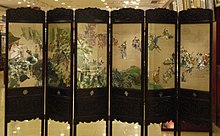Suzhou embroidery
It is famous for its variety of stitches, beautiful patterns, elegant colors, and consummate craftsmanship.
Because of its superior geographical environment, Suzhou is a city which is rich in producing silk.
Not only that, an imperial office was founded to oversee dyeing, weaving and embroidering for court use.
It was widely used to decorate clothing, costumes, quilts, pillow bags, curtains, cushions, shoes, sachets and other items.
At that time, it was the most popular art form for royal clothing and wall decoration.
[2] In the later part of the Qing dynasty, Su Xiu was further developed as an embroidery technology.
In the early 20th century, between 1912 and 1949, after the Xinhai Revolution, the Su Xiu industry declined.
After the founding of new China (after 1949), the government showed great concern for Su Xiu.
The traditional subjects of Su Xiu embroidery reflect characters and nature environment include figures, animals, mountains, rivers, flowers and birds.
Here are some classical Su embroidery works: "Lady Jiong Dances on a Golden Lotus Platform", a masterpiece made by a well-known Qing dynasty embroiderer called Ling Shu, it depicts imperial concubine Lady Jiong dancing for Emperor Li Yu of the Southern Tang dynasty.
Tools are: stretch frame, hand board, scissors, embroidery needle and tape measure.
[7] As a result, no knots or thread ends are visible in a double sided embroidery.
A favorite background is a series of overlapping circles which forms an all-over design of these coins.
Although the machine stitches are more convenient, they only play an auxiliary role and improve embroidery development, never replacing handwork.
The combination of two different cultures makes Su Xiu more acceptable to modern fashion, expanding into a new space.
In the Suorang 2012 collection, the design adopts method of combining embroidery with beads.
The ring with embroidery instead of gems or diamonds, break the viewers’ inherent imagination, thus deepening the visual experience.
The whole embroidery picture can be very impactful, but may not accord with the aesthetic concept of modern people.
Among them, the traditional Chinese calligraphy and painting have been incisively and vividly expressed in the Su Xiu works, which mostly draw the artistic essence from them.
Contemporary Chinese culture and art are also fully expressed in Su Xiu works.
Artists of Su Xiu embroidered their works with needles and threads instead of pigment.
Due to the artistic effect of silk, the calligraphy and painting patterns on the embroidery products appeared more vivid.
Whether it is to show landscapes, flowers, birds, animals or figures, exquisite Su embroidery skills can make it looks truly.
Suzhou embroidery inherits an ancient and traditional craft with strong national characteristics, and its value potential mainly comes from the scarcity and uniqueness of the works' resources.
Due to the complexity of Su Xiu technology, each process has different techniques, and a good embroidery product often takes several years or even longer to complete, which also leads to fewer and fewer people willing to learn and master Su embroidery techniques in contemporary fast-paced life.
In October 1986 (Ming dynasty), Suzhou city set up the Chinese embroidery art museum.
On May 24, 2018, Su Xiu was selected as one of the first batch of China national traditional craft revitalization and protection objects.











